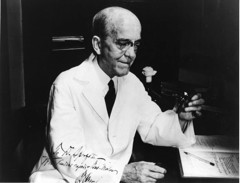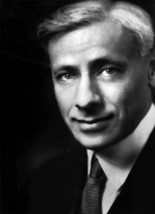The First Effective Vaccine for Pneumococcal Pneumonia

Avery, Oswald
Courtesy of the Rockefeller Archive Center
When the Rockefeller Hospital opened in 1910, pneumonia caused by the pneumococcus bacterium was a leading cause of death in the United States. Hundreds of patients were admitted to the hospital in a decades-long effort to understand, cure, and prevent this disease. Many of the achievements of this research program began with studies of the chemical nature of the thick envelope, or capsule, that surrounds pneumococcus, and is clearly visible with a light microscope. One line of investigation led, in the 1940s, to an effective vaccine against pneumococcal pneumonia. At about the same time, penicillin became available for treating the disease and the vaccine research was abandoned. But antibiotics were not always effective. In the 1970s the pneumococcus vaccine regained importance, through the efforts of an intellectual descendant of the original work. The story shows the success of research that flows from bedside to laboratory and back to the clinic, and also illustrates the important role of the hospital in training clinical investigators.

Pneumococcus bacteria have a characteristic gelatinous coating
In the 1920s and 1930s Oswald Avery's (1877-1955) laboratory was a hub of innovative research on the relationships between the chemical components of pneumococcus and the immune reactions the bacterium elicits. By 1923, Avery and Michael Heidelberger (1888-1991) had determined that the capsule of pneumococcus is composed of polysaccharides, or sugars. The capsules of the four known types of pneumococcus each had a different chemical composition. William Tillett (1892-1974) and Thomas Francis, Jr. (1900-1969) took up the task of investigating the immune response to infection. When they gave recovering pneumonia patients intradermal injections of polysaccharides of the same type as the patients' infections, a red welt developed, indicating the presence of antibodies to that type. Healthy individuals had no skin reaction on first injection, but developed a reaction with a second intradermal injection. This was the first demonstration that pure carbohydrates could be potent antigens.
The research of Tillett and Francis laid the groundwork for creating a type-specific polysaccharide pneumococcal vaccine. This effort was taken up by Colin MacLeod (1909-1972), who had joined the Avery laboratory in 1934, and Heidelberger, who had since moved to Columbia University. In 1944, they tested a vaccine that included four types of pneumococcal polysaccharides in more than 8,000 young men enrolled in a military technical school, about half the student population. Not only was the vaccine effective in those who received it, but since fewer vaccinated men now carried pneumococcus,the rate of infection was also reduced among those who did not receive the vaccine.
The vaccine was not tested again because penicillin became available for treating pneumococcal pneumonia. But even with antibiotics, pneumococcal infection continued to be a major cause of death, with more than 50,000 deaths each year in the United States in the early 1970s. Robert Austrian, who had trained in the laboratory of William Tillett at New York University (Tillett left Rockefeller in 1930), brought to public attention the need to prevent this infection. Using material from the 14 most common virulent strains of pneumococcus, he developed a new vaccine that was licensed in 1977. In recognition of their landmark contributions Heidelberger and Austrian received the 1978 Lasker Award. They shared this prize with Rockefeller's Emil Gotschlich, who developed a related vaccine against meningococcal diseases.
Oswald T. Avery received the BA from Colgate University (1900) and the MD from the College of Physicians and Surgeons in New York City (1904). He joined the Rockefeller Institute in 1913, where he remained for the rest of his career. His studies of pneumococcal pneumonia led to the discovery that DNA is the molecule of heredity. Among many awards and honorary degrees, Avery was elected to the U.S. National Academy of Sciences and received the Lasker Award (1947).

Michael Heidelberger, ca. 1930s. Courtesy of National Library of Science
Michael Heidelberger received his undergraduate degree and the PhD (1911) in chemistry from Columbia University. After a year of research in the Zurich laboratory of Richard Willstater, he joined the Rockefeller Institute in 1912. He left Rockefeller in 1927, and spent a year at Mount Sinai Hospital in New York before he was recruited to become chemist to the Presbyterian Hospital at Columbia University. He later became professor of biochemistry and professor of immunochemistry. In 1953 Heidelberger retired from Columbia and accepted a position at the Institute of Microbiology at Rutgers University. Nine years later he became adjunct professor in the Department of Pathology at the New York University School of Medicine. Heidelberger's long career spanned the twentieth century, and he published papers in each decade. His achievements were recognized with 15 honorary degrees and two Lasker Awards (1953, 1978), and he was elected to the U.S. National Academy of Sciences.
William S. Tillett graduated from the University of North Carolina in 1913, and received the MD from the Johns Hopkins University Medical School in 1917. He joined the Rockefeller Hospital in 1922. In 1930 he moved to Johns Hopkins University Medical School, and in 1937 to New York University, where he became professor and chairman of the Department of Medicine. Tillett, who discovered streptokinase, is best known for his research revealing the role enzymes play in blood-clotting. Among many awards and honors, Tillett received the Lasker Award (1949) and was elected to the U.S. National Academy of Sciences.
Thomas Francis, Jr. graduated from Allegheny College (1921) and received the MD from Yale University (1925). In 1928 he joined the Rockefeller Institute. Between 1935 and 1941, he served as professor of bacteriology and chair of the department at the New York University College of Medicine. In 1941 he joined the newly established School of Public Health at the University of Michigan, where he remained for the rest of his career. Francis is credited with being the first in the US to isolate the influenza virus, in 1935, and with developing the first killed-virus flu vaccine. He is also remembered for designing, supervising, and evaluating the 1950s field trials of the polio vaccine developed by his protege, Jonas Salk. Among many awards and honors, Francis received the US Presidential Medal of Freedom (1946) and was elected to the U.S. National Academy of Sciences. In 2005, the University of Michigan established the Thomas Francis, Jr. Medal in Global Public Health.
Colin MacLeod earned his MD from McGill University (1934). The next year he joined Oswald Avery's laboratory at the Rockefeller Institute, where he was a member of the group that discovered that DNA is the molecule that transmits heredity. In 1941 MacLeod became chairman of the Department of Microbiology at the New York University School of Medicine. Among his scientific achievements were field trials of an antipneumococcal vaccine. Aside from four years at the University of Pennsylvania (1956-1960), he remained at NYU. He was a member of the U.S. National Academy of Sciences.
Selected Publications
Heidelberger M and Avery OT. The soluble specific substance of pneumococcus. J Exp Med, 1923, 38: 73-79
http://jem.rupress.org/cgi/reprint/38/1/73
Tillett WS and Francis T Jr. Cutaneous reactions to the polysaccharides
and proteins of pneumococcus in lobar pneumonia. J Exp Med, 1929, 50:
687-701
http://jem.rupress.org/cgi/reprint/50/5/687
Francis T Jr and Tillett WS. Cutaneous reactions in pneumonia. The
development of antibodies following the intradermal injection of
type-specific polysaccharide. J Exp Med, 1930, 52: 573-585
http://jem.rupress.org/cgi/reprint/52/4/573
MacLeod CM, Hodges RG, Heidelberger M, and Bernhard WG. Prevention of
pneumococcal pneumonia by immunization with specific capsular
polysaccharides. J Exp Med, 1945, 82: 445-465
http://jem.rupress.org/cgi/reprint/82/6/445
Austrian R, Douglas RM, Schiffman G, Coetzee AM, Koornhof HJ, Hayden-Smith S, and Reid RD. Prevention of pneumococcal pneumonia by vaccination. Trans Assoc Am Physicians, 1976, 89: 184-194
Further Reading
Dochez AR. Oswald
Theodore Avery (1877-1955): A Biographical Memoir. Washington, DC:
National Academy of Sciences, 1958, pp. 29-49
http://www.nasonline.org/site/PageServer?pagename=MEMOIRS_A
Lawrence HS. William Smith Tillett, 1892-1974: A Biographical Memoir. Washington, DC: National Academy of Sciences, 1993
http://www.nasonline.org/site/PageServer?pagename=MEMOIRS_T
Paul JR. Thomas Francis, Jr. (1900-1969): A Biographical Memoir. Washington, DC: National Academy of Sciences, 1974, 44: 57-110
MacLeod CM. Thomas Francis, Jr., MD, 1900-1969. Arch Environ Health, 1970, 21: 226-229
Eisen HN. Michael Heidelberger (1888-1991): A Biographical Memoir.
Washington, DC: National Academy of Sciences, 2001, 80: 1-20
http://www.nasonline.org/site/PageServer?pagename=MEMOIRS_H
McDermott W. Colin Munro MacLeod (1909-1972): A Biographical Memoir.
Washington, DC: National Academy of Sciences, 1983, pp. 181-219
http://www.nasonline.org/site/PageServer?pagename=MEMOIRS_M
Links
Rockefeller Archive Center, Papers of Oswald T. Avery
http://www.rockarch.org/collections/individuals/ru/
National Library of Medicine, Profiles in Science: Oswald T. Avery
http://profiles.nlm.nih.gov/CC/
National Library of Medicine, Profiles in Science: Michael Heidelberger
http://profiles.nlm.nih.gov/DH
